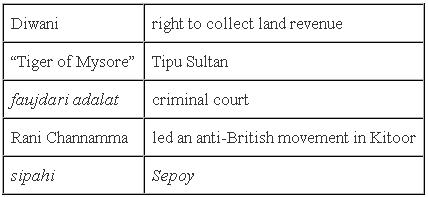Class 8 NCERT Solutions History Chapter 2 - From Trade to Territory
From Trade to Territory Exercise 24
Solution 1

Solution 2
(b) Haidar Ali and Tipu Sultan were the rulers of Mysore.
(c) Dalhousie implemented the Doctrine of Lapse.
(d)Maratha kingdoms were located mainly in the South-Western part of India.
Solution 4
India in the pre colonial period was known for its spices, cotton and silk textiles apart from its riches. The wealth of the country and the prospects of profitable trade which can arise out of the export of Indian articles to Europe attracted European trading companies to India.
Solution 5
The Company was granted a ‘farman’ by Aurangzeb for carrying out duty free trade in Bengal. However, the officials of the Company who were carrying on private trade activities also refused to pay the duty. This was causing a huge loss to the revenue of Bengal.
Another area of conflict between the Company and the nawabs were that the latter refused to grant concessions to the Company, asked for increased tributes and denied them the right to fortify their settlements. The Company on the other hand declared that the trade could flourish only if the duties are removed. It also wanted to fortify their settlements and buy villages in order to expand their trading activities.
From Trade to Territory Exercise 25
Solution 3
False
(b) The English East India Company was the only European company that traded with India.
False
(c) Maharaja Ranjit Singh was the ruler of Punjab.
True
(d)The British did not introduce administrative changes in the territories they conquered.
False
Solution 6
After the East India Company was appointed as the Diwan of the Bengal province, she made use of its vast resources. The British prior to 1765 had to import gold and silver form Britain for purchasing Indian goods. However, after it became the Diwan of Bengal, she used the revenues collected from the province for financing its trade with India, for building the Company’s fort and for maintaining its troops.
Solution 7
Subsidiary Alliance system was means used by the Company to extend its control over the Indian states. Main features of this system were:
- The Indian states entering into subsidiary alliance were protected by the Company’s forces but had to pay for the maintenance of the British troops.
- The Indian rulers were not allowed to have their independent armed forces.
- If the Indian rulers failed to make payments to the British, part of their kingdom was taken away as penalty.
- Hyderabad, Mysore, Awadh and Tanjore were some of the states that entered into the subsidiary alliance system with the British.
Solution 8
The Company laid down sound administrative system in India. Three cities of Bomaby, Madras and Calcutta were the main administrative centers of the Company. Each presidency was under the charge of the governors. The governor General was the head of the administration.A new judicial system was established in 1772. Each district had two courts- a criminal court known as ‘faujdari adalat’ and a civil court ‘diwani adalat’.The British also introduced a uniform military culture where the soldiers were provided with European style of training. European collectors presided over the civil courts. Pandits and the maulvis interpreted the Indian laws for them. Thus, the British laid down a sound system of administration in India.
The Indian rulers had however, a cntralised system of administration where the king had all the powers. The army of the rulers largely consisted of cavalry and was trained in conventional manner.
Solution 9
During the eighteenth century, when the East India Company began recruitment for its own army, it started recruiting peasants and began to train them as professional soldiers. The army came to be known as the sepoy army.
Like the Mughal army, the Company’s army was also composed of the cavalry and the infantry regiments, with the cavalry dominating the army.However, by the early nineteenth century, the British began to develop a uniform military culture. They began to provide European style of training for their soldiers. Strict discipline was enforced among its soldiers. At this time, the importance of cavalry declined. As the soldiers had to be armed with muskets and matchlocks, the infantry regiments became more important.

